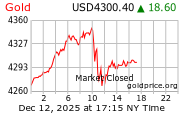Rising Gold Prices
In case people haven't noticed, the price of an ounce of gold is over $500/ounce for the first time since 1987. One of the best authorities on why this matters to us is Congressman Ron Paul of Texas. Here is his latest column:
What do Rising Gold Prices Mean?
December 5, 2005
The market price for an ounce of gold rose to over $500 last week, a significant milestone for economists watching precious metals and commodities markets. The last time gold topped $500 was December 1987, in the wake of the “Black Monday” stock market collapse earlier that fall.
Gold prices historically rise when faith in paper currencies erodes, as investors seek the intrinsic value of gold to protect themselves from inflation. It’s interesting to note that while the U.S. dollar has regained some of its value relative to other paper currencies like the Euro, it continues to lose value relative to gold and other hard assets. This shows the folly of using one fiat currency to value another.
Gold is history’s oldest and most stable currency. Central bankers and politicians don’t want a gold-backed currency system, because it denies them the power to create money out of thin air. Governments by their very nature want to expand, whether to finance military intervention abroad or a welfare state at home. Expansion costs money, and politicians don’t want spending limited to the amounts they can tax or borrow. This is precisely why central banks now manage all of the world’s major currencies.
Yet while politicians favor central bank control of money, history and the laws of economics are on the side of gold. Even though central banks try to mask their inflationary policies and suppress the price of gold by surreptitiously selling it, the gold markets always cut through the smokescreen eventually. Rising gold prices like we see today historically signify trouble for paper currencies, and the dollar is no exception.
President Nixon finally severed the last tenuous links between the dollar and gold in 1971. Since 1971, the Federal Reserve and U.S. Treasury have employed a pure fiat money system, meaning government can create money whenever it decrees simply by printing more dollars. The "value" of each newly minted dollar is determined by the faith of the public, the money supply, and the financial markets. In other words, fiat dollars have no intrinsic value.
What does this mean for you and your family? Since your dollars have no intrinsic value, they are subject to currency market fluctuations and ruinous government policies, especially Fed inflationary policies. Every time new dollars are printed and the money supply increases, your income and savings are worth less. Even as you save for retirement, the Fed is working against you. Inflation is nothing more than government counterfeiting by the Fed printing presses.





0 Comments:
Post a Comment
<< Home